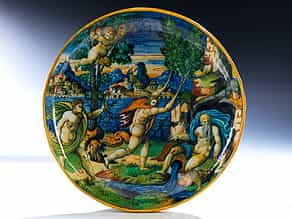Auction Maiolica
» reset
Your personal art agent

You would like to purchase a similar object?
We are happy to inform you, if similar works are to be auctioned in one of our upcoming auctions.
Please accept our privacy policy
411
Majolika-Istoriato-Schale auf Fuß mit Wappen
Durchmesser: 23,8 cm.
Urbino, um 1540 - 50.
Catalogue price € 10.000 - 12.000
Catalogue price€ 10.000 - 12.000
$ 10,800 - 12,960
£ 9,000 - 10,800
元 78,200 - 93,840
₽ 994,900 - 1,193,880
Im Spiegel nähert sich Apoll mit Bogen der Nymphe Daphne. Diese flieht nach rechts und verwandelt sich dabei in den Lorbeerstrauch. Rechts sitzt Daphnes Vater, der Flussgott Peneus, der sie verwandelt. Über der Szene schwebt Amor. Im Mittelgrund fließt ein breiter Fluss, dahinter eine befestigte Stadt in Flammen. Rand der Schale mit feiner Linie in Blau und Gelb. Detailreiche Szene, prächtig ausgeführt. Außen weiße Glasur. In der Bodenplatte des kleinen Fußes Wappen der römischen Familie Lanciere und Inschrift "daffan e? pollo" (für "Daphne und Apoll"). Durchgebrochen und rest. mit wenigen Ergänzungen. Bruchstellen auf der Vorderseite retouchiert, rückseitig sichtbar mit gebohrten Löchern für alte Reparatur-Klammer. Chips am Fuß.
Anmerkung:
Die Darstellung von Apoll und Daphne geht auf eine Geschichte aus Ovids Metamorphosen zurück. Amor schoss zwei Pfeile ab. Mit dem goldenen Pfeil traf er Apolls Herz, der sich darauf in Daphne verliebte. Der bleierne Pfeil traf die Nymphe Daphne, deren Herz darauf kalt blieb. Apoll jagte Daphne, die ihren Vater, den Flussgott Peneus bat, sie zu retten. Peneus verwandelte sie darauf in einen Lorbeerstrauch. Das Thema war in der Renaissance als Triumph der Keuschheit über die Liebe sehr populär.
Es ist ungewöhnlich, dass das Wappen auf die Rückseite gemalt wurde. Aus dem Service sind insgesamt 27 Teller bekannt.
Vgl.: Thornton und Wilson 2009, S. 310 - 312. Ein Teller aus diesem Service befindet sich im British Museum. Die Autoren schlagen vor, dass das Service für Leone Lancierini gefertigt worden sein könnte, der 1555 starb. Die verschiedenen Teller zeigen biblische und mythologische Themen.
Aus diesem Service existiert ein Teller mit der Abbildung der Zauberin Circe, vgl. Wendy Watson, "Italian Renaissance Ceramics, The Howard I. and Janet H. Stein Collection and the Philadelphia Museum of Art", Dezember 2001 - April 2002, Philadelphia, 2001, Kat. Nr. 72.
Ein Teller mit dem römischen Held Marcus Curtius, vgl. Tjark Hausmann, "Majolika. Spanische und italienische Keramik vom 14. bis 18. Jahrhundert", Katalog des Kunstgewerbemuseums Berlin VI, Berlin, 1972, S. 293f., Nr. 212.
Provenienz:
Dr. Chavaillon Collection; Hôtel des ventes de Châteleraullt, 10.-11.11.2002, Lot 67.
Literatur:
Aufgeführt bei Dora Thornton und Timothy Wilson, "Italian Renaissance Ceramics. A catalogue of the British Museum collection", Band 1, London, 2009, S. 310f., Fußnote 15. (8910314)
A Maiolica Istoriato Bowl on a Base and with a Coat of Arms
Diameter: 23.8 cm.
Duchy of Urbino, circa 1540 - 50.
On the bottom of the small base is a coat of arms of the Roman family Lanciere and the inscription "daffan e? Pollo" (for "Daphne and Apollo").
Broken and restored with a few additions. The cracks on the front have been retouched, they are visible on the reverse with drill holes for old repair clamps. Chips on the base.
Note:
The scene of Apollo and Daphne goes back to Ovids Metamorphoses. During the Renaissance the very popular theme was seen as the triumph of chastity over love. It is unusual that the coat of arms was painted on the back. Out of the service set, there are a total of 27 known plates.
Cf. lit. Thornton and Wilson 2009, pg. 310 - 312. One plate from the service set can be found at the British Museum. The authors suggest that the service set could have been made for Leone Lacierini, who died in 1555. The various plates show biblical and mythological scenes. There is one plate from the service set that depicts the witch Circe, cf. Wendy Watson, "Italian Renaissance Ceramics, The Howard I. and Janet H. Stein Collection and the Philadelphia Museum of Art," December 2001 - April 2002, Philadelphia 2001, cat. no. 72. One plate shows the Roman hero Marcus Curtius, cf. Tjark Hausmann, "Majolika. Spanische und Italienische Keramik vom 14. Bis 18. Jahrhundert," catalog from the Kunstgewerbemuseum Berlin VI, Berlin 1972, pg. 293f., no. 212.
Provenance:
Dr. Chavaillon Collection; Hôtel des ventes de Châteleraullt, 10.-11.11.2002, lot 67.
Literature:
mentioned by Dora Thornton and Timothy Wilson, "Italian Renaissance Ceramics. A catalogue of the British Museum collection," volume 1, London 2009, pg. 310f., footnote 15.
This object has been individually compared to the information in the Art Loss Register data bank and is not registered there as stolen or missing.
Your personal art agent
You would like to be informed of upcoming auctions if a similar work of art is offered? Activate your personal art agent here.
Please accept our privacy policy
You would like to purchase a similar object?
Your personal art agent Purchase in Private Sale Calendar
Our experts are happy to support you personally in your search for art objects.
You would like to sell a similar artwork in auction?
Consign now Private Sale Service FAQ
Your consignments are always welcome.
Our staff will be happy to personally assist you every step of the way. We look forward to your call.
Get in touch with our experts
further catalogues Furniture | Sculpture and Works of Art | Ivory, Rock Crystal & Silver with Enamel | Library 1 | Maiolica | 16th - 18th Century Paintings | Russian Art | Modern Art | Hampel Living | Porcelain | Silver | Library 2 | Asian Art | 19th - 20th Century Paintings | Folk Art & Miscellaneous


















